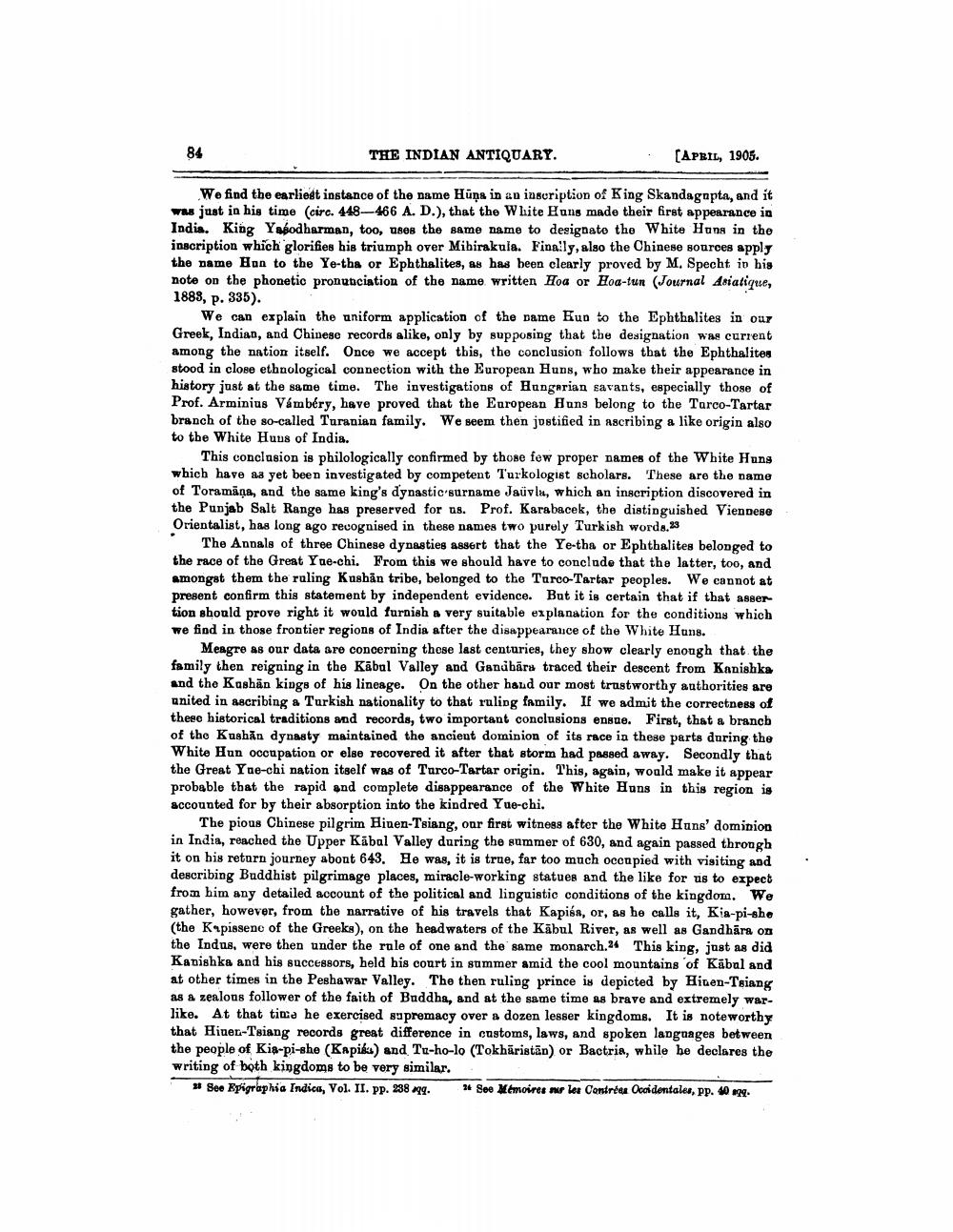________________
THE INDIAN ANTIQUARY.
[APRIL, 1905.
We find the earliest instance of the name Hüņa in an inscription of King Skandagapta, and it was just in his time (circ. 448-466 A. D.), that the White Huns made their first appearance in India. King Yabodharman, too, uses the same name to designato the White Hons in the inscription which glorifies his triumph over Mihirakula. Finally, also the Chinese sources apply the name Han to the Ye-ths or Ephthalites, as has been clearly proved by M. Specht in his note on the phonetic pronunciation of the name written Hoa or Hoa-tun (Journal Asiatique, 1888, p. 335).
We can explain the uniform application of the same Kun to the Ephthalites in our Greek, Indian, and Chinese records alike, only by supposing that the designation was current among the nation itself. Once we accept this, the conclusion follows that the Ephthalites stood in close ethnological connection with the European Huns, who make their appearance in history just at the same time. The investigations of Hungarian savants, especially those of Prof. Arminius Vámbéry, have proved that the European Huns belong to the Tarco-Tartar branch of the so-called Turanian family. We seem then justified in ascribing a like origin also to the White Hous of India.
This conclusion is philologically confirmed by those few proper names of the White Huns which have as yet been investigated by competent Turkologist scholars. These are the name of Toramāņa, and the same king's dynastic surname Jauvla, which an inscription discovered in the Punjab Salt Range has preserved for us. Prof. Karabacek, the distinguished Viennese Orientalist, has long ago recognised in these names two purely Turkish words.23
The Annals of three Chinese dynasties assert that the Ye-tha or Ephthalites belonged to the race of the Great Yae-chi. From this we should have to conclude that the latter, too, and amongst them the ruling Kushần tribe, belonged to the Turco-Tartar peoples. We cannot at present confirm this statement by independent evidence. But it is certain that if that assertion should prove right it would furnish a very suitable explanation for the conditions which we find in those frontier regions of India after the disappearance of the White Huns.
Meagre as our data are concerning these last centuries, they show clearly enough that the family then reigning in the Kābul Valley and Ganibāra traced their descent from Kanishka and the Kashăn kings of his lineage. On the other hand our most trustworthy authorities are united in ascribing a Turkish nationality to that ruling family. If we admit the correctness of these historical traditions and records, two important conclusions ensue. First, that a brancb of the Kushaa dynasty maintained the ancient dominion of its race ia these parts during the White Hun occupation or else recovered it after that storm had passed away. Secondly that the Great Yne-chi nation itself was of Turco-Tartar origin. This, again, would make it appear probable that the rapid and complete disappearance of the White Hans in this region is accounted for by their absorption into the kindred Yue-chi.
The pious Chinese pilgrim Hinen-Tsiang, our first witness after the White Huns' dominion in India, reached the Upper Käbal Valley during the summer of 630, and again passed through it on his return journey about 643. He was, it is true, far too much occupied with visiting and describing Buddhist pilgrimage places, miracle-working statues and the like for us to expect from him any detailed account of the political and linguistic conditions of the kingdom. We gather, however, from the narrative of his travels that Kapisa, or, as he calls it, Kia-pi-she (the Kapissene of the Greeks), on the head waters of the Kabul River, as well as Gandhāra on the Indus, were then under the rule of one and the same monarch.24 This king, just as did Kanishka and his successors, held his court in summer amid the cool mountains of Kabal and at other times in the Peshawar Valley. The then ruling prince is depicted by Hiuen-Tsiang as a zealous follower of the faith of Buddha, and at the same time as brave and extremely warlike. At that time he exercised supremacy over a dozen lesser kingdoms. It is noteworthy that Hiner-Tsiang records great difference in customs, laws, and spoken languages between the people of Kis-pi-she (Kapik) and To-ho-lo (Tokhāristān) or Bactria, while he declares the writing of both kingdoms to be very similar..
*See Epigraphia Indica, Vol. II. pp. 298 299. ** See Mémoires sur les Controa Occidentales, pp. 1039.




